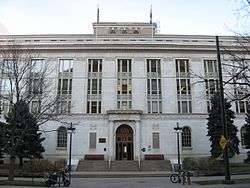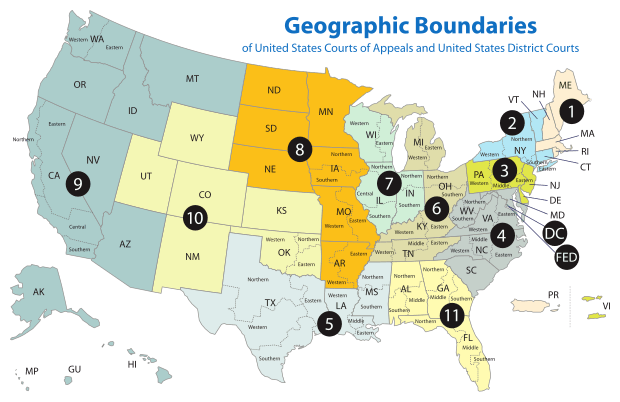United States District Court for the District of Colorado
| United States District Court for the District of Colorado | |
|---|---|
| (D. Colo.) | |
| Location | Denver |
| Appeals to | Tenth Circuit |
| Established | June 26, 1876 |
| Judges | 7 |
| Chief Judge | Marcia S. Krieger |
| Officers of the court | |
| U.S. Attorney | Jason R. Dunn |
| U.S. Marshal | David A. Weaver |
|
www | |

The United States District Court for the District of Colorado (in case citations, D. Colo. or D. Col.) is a federal court in the Tenth Circuit (except for patent claims and claims against the U.S. government under the Tucker Act, which are appealed to the Federal Circuit).
The District was established on June 26, 1876, pending Colorado statehood on August 1, 1876.[1]
The United States Attorney for the District is Jason R. Dunn.
Organization of the court
The United States District Court for the District of Colorado is the sole federal judicial district in Colorado.[2] Court for the District is held at Colorado Springs, Denver, Durango, and Grand Junction.
Current judges
| # | Title | Judge | Duty station | Born | Term of service | Appointed by | ||
|---|---|---|---|---|---|---|---|---|
| Active | Chief | Senior | ||||||
| 21 | Chief Judge | Marcia S. Krieger | Denver | 1954 | 2002–present | 2013–present | — | G.W. Bush |
| 24 | District Judge | Philip A. Brimmer | Denver | 1959 | 2008–present | — | — | G.W. Bush |
| 25 | District Judge | Christine Arguello | Denver | 1955 | 2008–present | — | — | G.W. Bush |
| 26 | District Judge | William J. Martínez | Denver | 1954 | 2010–present | — | — | Obama |
| 27 | District Judge | R. Brooke Jackson | Denver | 1947 | 2011–present | — | — | Obama |
| 28 | District Judge | Raymond P. Moore | Denver | 1953 | 2013–present | — | — | Obama |
| 29 | District Judge | vacant | — | — | — | — | — | — |
| 11 | Senior Judge | Richard Paul Matsch | Denver | 1930 | 1974–2003 | 1994–2000 | 2003–present | Nixon |
| 12 | Senior Judge | John L. Kane Jr. | Denver | 1937 | 1977–1988 | — | 1988–present | Carter |
| 16 | Senior Judge | Lewis Thornton Babcock | Denver | 1943 | 1988–2008 | 2000–2007 | 2008–present | Reagan |
| 19 | Senior Judge | Wiley Young Daniel | Denver | 1946 | 1995–2013 | 2008–2012 | 2013–present | Clinton |
| 22 | Senior Judge | Robert E. Blackburn | Denver | 1950 | 2002–2016 | — | 2016–present | G.W. Bush |
Vacancies and pending nominations
| Seat | Seat last held by | Vacancy reason | Date of vacancy | Nominee | Date of nomination |
|---|---|---|---|---|---|
| 6 | Robert E. Blackburn | Senior Status | April 12, 2016 | Daniel D. Domenico | January 8, 2018 |
| 4 | Marcia S. Krieger | March 3, 2019[3] | – | – |
Former judges
| # | Judge | State | Born–died | Active service | Chief Judge | Senior status | Appointed by | Reason for termination |
|---|---|---|---|---|---|---|---|---|
| 1 | Moses Hallett | CO | 1834–1913 | 1877–1906 | — | — | Grant | retirement |
| 2 | Robert E. Lewis | CO | 1857–1941 | 1906–1921 | — | — | T. Roosevelt | appointment to 8th Cir. |
| 3 | John Foster Symes | CO | 1878–1951 | 1922–1950 | — | 1950–1951 | Harding | death |
| 4 | William Lee Knous | CO | 1889–1959 | 1950–1959 | 1954–1959 | — | Truman | death |
| 5 | Jean Sala Breitenstein | CO | 1900–1986 | 1954–1957 | — | — | Eisenhower | appointment to 10th Cir. |
| 6 | Alfred Albert Arraj | CO | 1906–1992 | 1957–1976 | 1959–1976 | 1976–1992 | Eisenhower | death |
| 7 | Olin Hatfield Chilson | CO | 1903–1991 | 1960–1973 | — | 1973–1991 | Eisenhower | death |
| 8 | William Edward Doyle | CO | 1911–1986 | 1961–1971 | — | — | Kennedy | appointment to 10th Cir. |
| 9 | Fred M. Winner | CO | 1912–2003 | 1970–1982 | 1976–1982 | 1982–1984 | Nixon | retirement |
| 10 | Sherman Glenn Finesilver | CO | 1927–2006 | 1971–1994 | 1982–1994 | 1994 | Nixon | retirement |
| 13 | James R. Carrigan | CO | 1929–2014 | 1979–1994 | — | 1994–1995 | Carter | retirement |
| 14 | Zita Leeson Weinshienk | CO | 1933–present | 1979–1998 | — | 1998–2011 | Carter | retirement |
| 15 | John Carbone Porfilio | CO | 1934–present | 1982–1985 | — | — | Reagan | appointment to 10th Cir. |
| 17 | Edward Nottingham | CO | 1948–present | 1989–2008 | 2007–2008 | — | G.H.W. Bush | resignation |
| 18 | Daniel B. Sparr | CO | 1931–2006 | 1990–2001 | — | 2001–2006 | G.H.W. Bush | death |
| 20 | Walker David Miller | CO | 1939–2013 | 1996–2008 | — | 2008–2013 | Clinton | death |
| 23 | Phillip S. Figa | CO | 1951–2008 | 2003–2008 | — | — | G.W. Bush | death |
Chief judges
Chief judges have administrative responsibilities with respect to their district court. Unlike the Supreme Court, where one justice is specifically nominated to be chief, the office of chief judge rotates among the district court judges. To be chief, a judge must have been in active service on the court for at least one year, be under the age of 65, and have not previously served as chief judge. A vacancy is filled by the judge highest in seniority among the group of qualified judges. The chief judge serves for a term of seven years or until age 70, whichever occurs first. The age restrictions are waived if no members of the court would otherwise be qualified for the position.
When the office was created in 1948, the chief judge was the longest-serving judge who had not elected to retire on what has since 1958 been known as senior status or declined to serve as chief judge. After August 6, 1959, judges could not become or remain chief after turning 70 years old. The current rules have been in operation since October 1, 1982.
Succession of seats
|
|
|
|
| ||||||||||||||||||||||||||||||||||||||||||||||||||||||||||||||||||||||||||
|
|
|
| ||||||||||||||||||||||||||||||||||||||||
See also
References
- ↑ http://www.fjc.gov/history/home.nsf/page/courts_district_co.html U.S. District Courts of Colorado, Legislative history, Federal Judicial Center
- ↑ 28 U.S.C. § 85
- ↑ Future Judicial Vacancies
